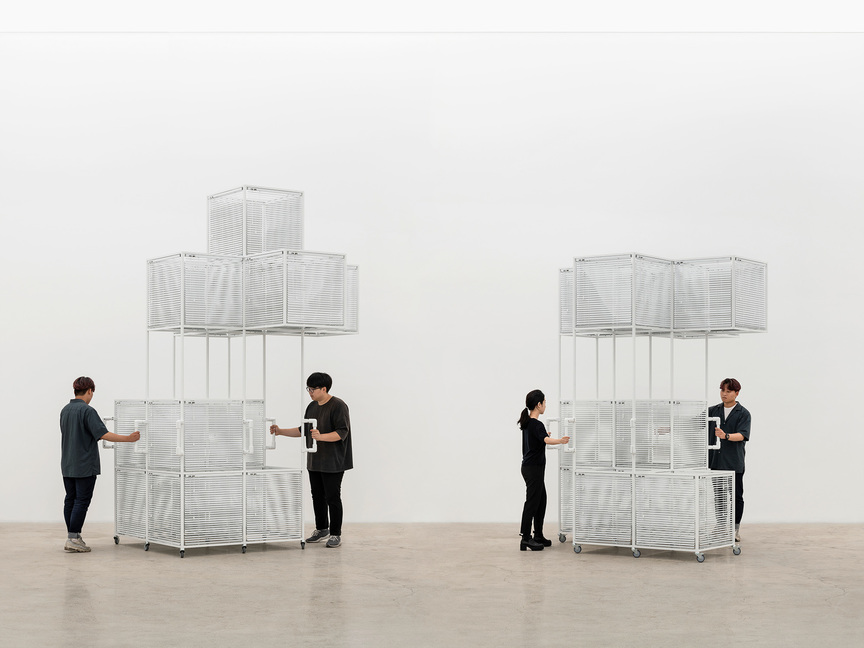-
From Current Issue
-
- Editor’s Letter Fire in the Heart
- Reviews I Gusti Ayu Kadek Murniasih
- Reviews 11th Seoul Mediacity Biennale: “One Escape at a Time”
- Dispatch Networked China
- One on One Monira Al Qadiri on Yukio Mishima
- Essays The rise of independent art spaces in pandemic-era Shanghai
- Features Tuan Andrew Nguyen
- Table of Contents
- Web Exclusives
- Archive
- Subscribe

R
E
V N
E
X
T
Installation view of HAEGUE YANG’s “When The Year 2000 Comes,” at Kukje Gallery, Seoul, 2019. Photo by Chunho An. Courtesy Kukje Gallery, Seoul / Busan.
Thinking about our personal lives outside of societal history is an impossibility. Landmark dates of sociopolitical significance become events, or non-events (Y2K), in our own lives. Haegue Yang’s exhibition “When The Year 2000 Comes” addressed this intractable intertwining of personal and societal pasts through an ecosystem-like environment of visual, textual, aural, and olfactory elements that formed a simulation, or even exaggeration, of a fragmented post-millennium global society, characterized by excessive material production and consumption, and revivals of traditional crafts and national histories.
Outside the entrance of Kukje Gallery’s K3 space, visitors heard a song playing from a hidden speaker: Hae-kyung Min’s 1982 power-disco track “AD 2000.” With lyrics spelling out platitudes of space travel and world peace, the song projects optimism for an imagined future, one that is now in our past, though that vision never fully materialized either. In the gallery’s small glass-walled foyer was a 1977 drawing of a pirate ship beset by monsters and flying dinosaurs created by Yang and her two brothers as children. The density of characters, their anachronistic histories, and their distribution across the sky, sea, and land became a codex for the exhibition.
Inside the gallery, low-hanging mist covered the floors, evoking a tropical environment, while a white spotlight swept around the space. The protagonists were a pair of Sol LeWitt Vehicles (2018– ), white, wheeled cubic structures with venetian-blind compartments that are hybrids of two earlier series: Dress Vehicles (2011– ) and Sol LeWitt Upside Down (2015– ). Rolling around the space were a dozen lunar-looking exercise balls that emit an artificially derived “earth” scent, while four Sonic Gym (2019) sculptures—suspended orbs covered in black, gold, or silver bells like those used in Korean shamanic rituals—were periodically turned by gallery attendants. The wallpaper, Incubation and Exhaustion (2018), was a digital collage featuring garlic bulbs, verdant mountains, diagrams of black holes, robotic medical devices, bags of spices, and burning trees, collaboratively designed with Manuel Raeder, to reflect the topography and agriculture-meets-tech economy of southwestern France for a previous exhibition in Montpellier. It was partially overlaid by a holographic grid referencing a Korean chessboard that extended up from the floor.
The soundtrack of birdsong, interspersed with the clicking of cameras, derived from the 2018 Inter-Korean Summit, when the North and South Korean leaders conversed out of earshot in the incidentally biodiverse Demilitarized Zone. On select occasions the gallery was further populated by LED-illuminated, soccer-ball-shaped flying drones. Analogous to Yang’s combination of disparate environmental elements was an account of the intertwined but non-intersecting lives of French writer Marguerite Duras and Korean composer Isang Yun “subjectively edited” by the artist. Live performances of Yun’s “Images” (1968), inspired by his visit to the Great Tomb of Gangseo in North Korea, invoked the specter of Korea’s turbulent modern history and its impact on the avant-garde; Yun was later accused of spying for the North by the Park Chung-hee regime. The evocation of Duras brought the element of personal desire and her dichotomy of together-yet-apart that drives Yang’s reflections on ideas of communities.
Partial installation view of HAEGUE YANG’s “When The Year 2000 Comes,” at Kukje Gallery, Seoul, 2019. Photo by Chunho An. Courtesy Kukje Gallery, Seoul / Busan.
Collectively these objects and images did not cohere in a narrative formation so much as they circulated within Yang’s choreography. The natural world was flattened to graphics, human lives into written episodes, while the industrially produced, custom-modified objects were arranged together so as to be strangely biomorphic. Beginning with Series of Vulnerable Arrangements – Version Utrecht (2006), Yang’s installations have featured humidifiers, scent emitters, fans, and spotlights in sparse arrangements that deconstructed the “climate” of indoor spaces. But in “When The Year 2000 Comes,” the environment verged on the lush spontaneity of an ecosystem, with chirping birds, waves of fog, flying drones, and both terrestrial and airborne sculptures. The many paradoxical, antagonistic elements of “When The Year 2000 Comes” recalls Tom McDonough’s description of Yang’s works as “amphibological”— that is, “holding [opposing characteristics] both together in the mind simultaneously.” Yet even to dichotomize the elements at play here is to reduce their amphi-morphous qualities. As a total environment, “When The Year 2000 Comes” returned us to the future of our past, which still haunts us with its torments and its promises.
HG Masters is ArtAsiaPacific’s deputy publisher and deputy editor.
Haegue Yang’s “When The Year 2000 Comes” is on view at Kukje Gallery, Seoul, until November 17, 2019.
To read more of ArtAsiaPacific’s articles, visit our Digital Library.

















